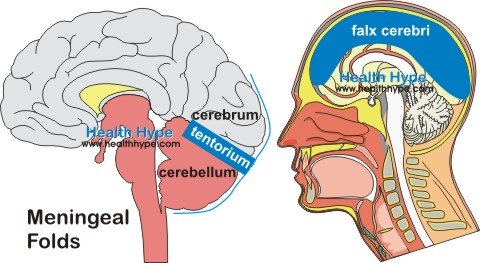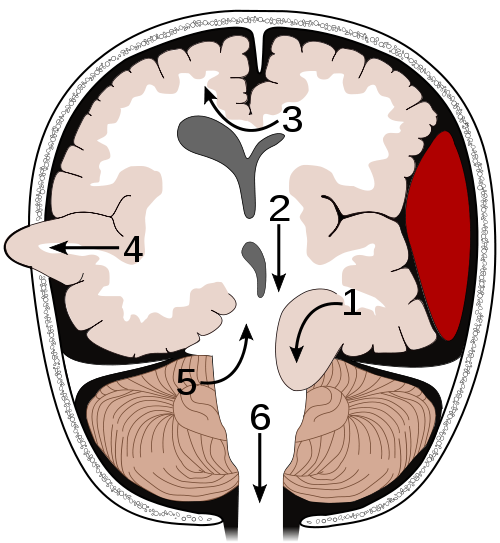Brain Herniation – Causes of Different Types of Hernias
The cranial cavity houses the brain and related structures but it is a rigid compartment that will not accommodate expansion of the tissues and fluid within. The dural folds are also rigid dividers that compartmentalize the different parts of the brain. The softer tissue of the brain therefore presses against the bone or dural folds or protrudes through any openings should there be swelling or bleeding within the parenchyma or cranial cavity. Read more on swelling of the brain and bleeding in the brain.
What is a brain herniation?
A brain herniation syndrome is when the brain tissue is pushed from its normal position and protrudes into adjacent compartments or may even push out of the skull if there is an opening present. In order to understand how a herniation develops and the different types of brain herniation syndromes, it is important to have a basic knowledge of intracranial anatomy.
The brain is housed in the hard and bony cranial cavity of the skull. The opening at the base of the skull through which the medulla oblongata, an extension of the spinal cord, exits the skull is known as the foramen magnum. It is one opening for brain tissue to protrude through. The brain is covered by the meninges, which comprise three layers – pia, arachnoid and dura mater. The dura mater thickens and folds on itself to project into two sites :
- between the left and right hemispheres of the brain (cerebrum) where it is known as the falx cerebri.
- between the occipital lobe of the brain (cerebrum) and cerebelllum where it is known as the tentorium cerebelli.
Different Types of Brain Herniation
There are four different types of brain herniation :
- Uncinate/Uncal rranstentorial herniation
- Central transtentorial herniation
- Subfalcine (cingulate) herniation
- Extracranial (transcalvarial) herniation
- Upward cerebellar herniation
- Tonsillar (downward cerebellar) herniation
Picture from Wikimedia Commons
The four main types of brain herniation syndromes include an uncinate and central transtentorial herniations, as well as a subfalcine or tonsillar herniations.
An uncinate or uncal transtentorial herniation (1) occurs when the inner part (medial aspect) of the temporal lobe is pushed against the free margin of the tentorium. In severe cases, it can compress the brainstem. Another type, known as a central transtentoral herniation, or just a central herniation (2), occurs when there is downward pressure centrally. It may cause a bilateral uncal herniation, meaning an uncal herniation (1) on both sides.
A subfalcine herniation (3) occurs when there is uneven, usually one-sided expansion of the cerebral hemisphere which pushes a portion of the brain tissue known as the cingulate gyrus under the falx cerebri. Hence this type of herniation is also known as a cingulate herniation.
The fourth main type of brain herniation is known as the tonsillar herniation and involves the cerebellum. Swelling or bleeding within the cerebellum pushes the cerebellar tonsils downwards into the foramen magnum. It is also known as the downward cerebellar herniation and can be life-threatening because it compresses the brainstem. A less commonly seen cerebellar herniation is the upward cerebellar herniation (5) where pressure from the back of the cranial cavity pushes the cerebellar tissue upwards.
An extracranial herniation (4) is when the brain tissue pushes through an opening in the cranial cavity formed by trauma or at a surgical site. It is also known as a transcalvarial herniation.
Causes of Brain Herniation
A brain herniation is a consequence of raised intracranial pressure where the force pushes the brain tissue in a specific direction and angle. This may be diffuse meaning that it is occurring throughout the brain tissue or cranial cavity or focal (localized) where it is only occurring at a specific portion of the brain or cranial cavity.
- Diffuse Causes
- Generalized swelling of the brain
- Hydrocephalus
- Focal Causes
- Abscess
- Tumor
- Intracranial hematoma


